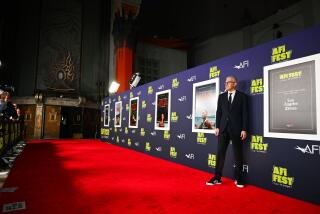Alex Theatre Offering Sure to Keep Audience in Suspense
- Share via
Not everything about “North by Northwest” withstands the test of time. The Cold War stuff is awfully dated, and so is the good girl / bad girl business involving Eve Kendall, played with such style and world-weariness by Eva Marie Saint.
But so much of Alfred Hitchcock’s classic film is just right, from Cary Grant’s roguish sophistication as the beleaguered Roger Thornhill to the way Hitchcock turns a mundane crop duster into a perfect killing machine. And then there is James Mason’s wonderfully suave villain. And the quirky henchman, played by Martin Landau, who is clearly so mad about Mason’s Vandamm that the role is considered one of the milestones in Hollywood’s “celluloid closet.”
When Hitchcock made the film in 1958 (it was released in 1959), he was at the peak of his powers and had not yet begun the long slide into violent misogyny that makes later films such as “Frenzy” almost unbearable to watch. In “North by Northwest,” as in “Rear Window,” Hitchcock functions as a macabre Lubitsch, a maker of grown-up entertainments with a bonus--heart-stopping moments of suspense.
The Alex Film Society will screen “North by Northwest” this Saturday, along with the Oscar-winning Tom & Jerry cartoon “Quiet, Please.” What better way to see the Hitchcock film than on a large screen? After all, the defining motif is the array of epic presidential heads carved by Gutson Borglum onto the face of Mt. Rushmore. This is political clout writ large, in the manner of the Pharaonic statues that stood at Abu Simbel, not at all the sort of thing you want to see on your VCR.
Donald Spoto’s 1983 biography of Hitchcock, “The Dark Side of Genius,” is full of fun facts about the movie.
“North by Northwest” was written by Ernest Lehman with Cary Grant in mind, and Hitchcock was in the awkward position of having to keep at bay Jimmy Stewart, who very much wanted to make Hitch’s next picture as well as his last (“Vertigo”). Jessie Royce Landis, one of the director’s favorite character actresses, was actually a year younger than Grant, who plays her son. And Hitchcock personally picked Saint’s chic wardrobe, boasting, “I acted just like a rich man keeping a woman: I supervised the choice of her wardrobe in every detail.”
*
Robert Boyle, who was the art director on this and many other Hitchcock films, talks about working with the master. “He was very demanding, but he was also the most collaborative of any director I ever worked with,” he says. Hitchcock always had the last word, but he never micro-managed, according to Boyle. “Since you were a professional, he expected you to do your job.”
Hitchcock got into a famous squabble with the U.S. government over how respectfully he planned to treat the South Dakota monument in his film. According to Spoto, the Feds became alarmed after a diagram Hitch had drawn for a journalist on a napkin was published, showing how the characters would move back and forth across the presidential faces. Boyle recalled that the government was alarmed by the working title of the project, “The Man on [some recall in] Lincoln’s Nose.”
Whatever the proximate cause, Hitchcock was officially banned from showing his actors doing anything on the faces, even in scenes shot in the studio. Boyle said they never intended to have their actors actually climb around on the monument. “You couldn’t have Cary Grant and Eva Marie Saint hanging over those statues.”
Instead, Boyle and the rest of the Hitchcock team resorted to the myriad tricks of their trade. Boyle was lowered down the face of the mountain, in front of each head, and took photos every 10 feet. In the studio, these still photos were projected onto a translucent screen behind the actors to create the hair-raising climactic scenes.
The film is one of Boyle’s favorites.
“I think I enjoyed it the most,” he says. “It presented so many technical problems. Much of it you would probably do today using computer-generated images.”
Boyle, who worked on “Saboteur,” “Shadow of a Doubt,” “The Birds” and “Marnie,” was hired for “North by Northwest” while it was still being written. Hitchcock was wise to invest so much time in pre-production, Boyle believes. Too many contemporary filmmakers think of pre-production as a luxury. “It was Hitch’s thesis, and mine, too, that it’s the least expensive time you have,” Boyle says. “You can do some thinking.”
*
Boyle has been asked to appear at the evening show at the Alex, as has Leonard South, who was the camera operator on the picture. Hitchcock worked in the British film tradition, where the director of photography is in charge of lighting, while the camera operator works with the director to determine the angles, coverage and dolly moves.
A former president of the American Society of Cinematographers, South first worked with Hitchcock on “Strangers on a Train” in 1951 and last worked with him during pre-production of the unnamed spy movie Hitch was planning when he died in 1980.
DETAILS
* WHAT: Screenings of Alfred Hitchcock’s “North by Northwest” by the Alex Film Society.
* WHERE: Alex Theatre, 216 N. Brand Blvd., Glendale.
* WHEN: 2 p.m. and 8 p.m. Saturday (personal appearances in the evening only).
* HOW MUCH: $7.50 evening, $6 matinee and film society members.
* CALL: (818) 243-ALEX.
More to Read
Only good movies
Get the Indie Focus newsletter, Mark Olsen's weekly guide to the world of cinema.
You may occasionally receive promotional content from the Los Angeles Times.







